Maths Olympiad Previous Year Paper -3 | Maths Olympiad Class 6 PDF Download
| Table of contents |

|
| Logical Reasoning |

|
| Mathematical Reasoning |

|
| Everyday Mathematics |

|
| Achievers Section |

|
Note: The questions provided in this document are similar to the questions that were asked in the actual Olympiad exam. So, we recommend you study these for your Olympiad preparation
Logical Reasoning
Q1: P is the father of Q. R and S are sons of Q. T is the mother of S. How is T related to P?
(a) Wife
(b) Daughter
(c) Daughter-in-law
(d) Mother
 View Answer
View Answer 
Ans: (c)
- P is the father of Q, making Q his child.
- R and S are the sons of Q, which means P is their grandfather.
- T is the mother of S, which means she is married to Q.
- Thus, T is the daughter-in-law of P because she is the wife of P's son Q.
Q2: If P is referred to as ‘÷’, Q as ‘×’, R as ‘+’ and S as ‘–’, what is the result of 20P4Q7R3S7?
(a) 32
(b) 31
(c) 33
(d) 36
 View Answer
View Answer 
Ans: (b)
- First, replace the symbols with their meanings: 20 ÷ 4 × 7 + 3 – 7.
- Next, perform the operations in the correct order: start with division and multiplication from left to right.
- Calculate: 20 ÷ 4 = 5, then 5 × 7 = 35.
- Now, add and subtract: 35 + 3 = 38, and finally 38 – 7 = 31.
Q3: Complete the series 6, 11, 31, 121, 601, ?
(a) 3369
(b) 3660
(c) 3601
(d) 6788
 View Answer
View Answer 
Ans: (c)
First Term = 6.
Second term = 6 x 2 -1 = 11.
Third term = 11 x 3 - 2 = 31.
Fourth term = 31 x 4 - 3 = 124 -3 = 121.
Fifth term = 121 x 5 - 4 = 601.
Sixth term = 601 x 6 = 3606 - 5 = 3601.
Q4: Select the odd one out.
(a) 81
(b) 36
(c) 47
(d) 16
 View Answer
View Answer 
Ans: (c)
47 is not a perfect square, and it is also a prime number.
Rest all are composite numbers and are perfect squares.
Q5: Which number comes next in the sequence: 2, 4, 8, 16, …?
(a) 24
(b) 32
(c) 18
(d) 30
 View Answer
View Answer 
Ans: (b)
The sequence is doubling each time. (2×2=4, 4×2=8, 8×2=16, so 16×2=32).
Q6: In a row of trees, a tree is 7th from either end of the row. How many trees are there in the row?
(a) 13
(b) 14
(c) 15
(d) 12
 View Answer
View Answer 
Ans: (a)
If the tree is 7th from either end, there are 6 trees on each side of it, making a total of 6 + 6 + 1 = 13 trees.
Q7: If the 9th day of a month is 4 days earlier than Wednesday, what will be 20th day of the month?
(a) Monday
(b) Tuesday
(c) Wednesday
(d) Thursday
 View Answer
View Answer 
Ans: (c)
Q8: Ruby: Red : : Sapphire : ?
(a) Blue
(b) White
(c) Green
(d) Silver
 View Answer
View Answer 
Ans: (a)
A Ruby is a red precious stone and sapphire is a blue precious stone.
Q9: In the following question, select the missing number from the given series.
23, 11, 34, 45, 79, ?
(a) 121
(b) 124
(c) 163
(d) 169
 View Answer
View Answer 
Ans: (b)
23+11=34
11+34=45
34+45=79
45+79=124.
Q10: In the following question, select the related number from the given alternatives.
8 : 63 : : 9 : ?
(a) 80
(b) 81
(c) 56
(d) 32
 View Answer
View Answer 
Ans: (a)
82 = 64 - 1= 63
92 = 81 - 1 =80
Q11: In the following question, select the word which cannot be formed using the letters of the given word.
TRADITIONAL
(a) LAID
(b) TRADE
(c) RADIATION
(d) RATIONAL
 View Answer
View Answer 
Ans: (b)
Letter ‘E’ is absent in the above word hence, word ‘TRADE can’t be formed.
Q12: A solid cube is divided into 27 smaller cubes of equal volume. If two opposite faces of this bigger cube are painted with different colours and remaining faces are left unpainted, then how many smaller cubes are obtained which have no faces painted?
(a) 1
(b) 9
(c) 27
(d) 36
 View Answer
View Answer 
Ans: (b)
Q13: If A means '+', B means '-' C means '×' and D means '÷' then 18 C 14 A 6 B 16 D 4 =?
(a) 188
(b) 238
(c) 254
(d) 288
 View Answer
View Answer 
Ans: (c)
Q14: My mother is three times older than my sister. My father is 30 years elder to me. I was five years old when my sister born. If the present age of my sister is 15 years, then the difference of my parents’ age is
(a) 3
(b) 2
(c) 5
(d) 10
 View Answer
View Answer 
Ans: (c)
Q15: Select the letter pair that has the same relationship as the original pair of words.
Hospital : Doctor
(a) Army : Soldier
(b) School : Teacher
(c) Lawyer : Court
(d) College : Student
 View Answer
View Answer 
Ans: (b)
Mathematical Reasoning
Q16: What is the difference between the successor and predecessor of the number 205575?
(a) 4
(b) 3
(c) 2
(d) 6
 View Answer
View Answer 
Ans: (c)
- The successor of a number is the number that comes immediately after it, while the predecessor is the number that comes immediately before it.
- For the number 205575, the successor is 205576 and the predecessor is 205574.
- The difference between the successor and predecessor is calculated as 205576 - 205574, which equals 2.
- Thus, the correct answer is 2.
Q17: Examine the sequence closely and determine the number that is absent.
1 × 3 + 1 = 4 = (2)2
3 × 5 + 1 = 16 = (4)2
5 × 7 + 1 = 36 = (6)2
7 × 9 + 1 = 64 = (8)2
9 × 11 + 1 = ______
(a) (10)2
(b) (11)2
(c) (12)2
(d) (9)2
 View Answer
View Answer 
Ans: (a)
- The pattern involves a formula where each step follows the structure: n × (n + 2) + 1 = (n + 1)2 .
- For example, in the first case, 1 × 3 + 1 = 4, which equals (2)2 .
- Continuing this, the last known calculation is 9 × 11 + 1 = 64, which equals (8)2 .
- Following the pattern, the next step would be 10 × 12 + 1 = 121, which equals (10)2 .
Q18: The total of the additive inverse of –100 and the additive inverse of 52 is:
(a) –48
(b) 48
(c) 100
(d) –52
 View Answer
View Answer 
Ans: (b)
- To find the additive inverse, we change the sign of the number.
- The additive inverse of –100 is 100.
- The additive inverse of 52 is –52.
- Now, we add these two results: 100 + (–52) = 100 - 52 = 48.
- Thus, the answer is 48.
Q19: Compare and fill in the box:
2/7 + 3/21 + 5/14 ____ 3/7 + 2/6 + 1/42
(a) >
(b) <
(c) =
(d) Can’t be determined
 View Answer
View Answer 
Ans: (c)
- First, we need to find a common denominator for both sides of the equation. The common denominator for the fractions on the left side (2/7, 3/21, 5/14) is 42.
- Convert each fraction: 2/7 = 12/42, 3/21 = 6/42, and 5/14 = 15/42. Adding these gives us 12/42 + 6/42 + 15/42 = 33/42.
- Now, for the right side (3/7, 2/6, 1/42), the common denominator is also 42. Convert: 3/7 = 18/42, 2/6 = 14/42, and 1/42 = 1/42. Adding these gives us 18/42 + 14/42 + 1/42 = 33/42.
- Now we compare: 33/42 = 33/42, so the answer is equal.
Q20: Simplify: 
(a) 14/45
(b) 13/45
(c) 16/45
(d) 12/45
 View Answer
View Answer 
Ans: (b)
- First, convert the mixed numbers into improper fractions: 4 3/5 = 23/5, 2 7/9 = 25/9, and 1 2/15 = 17/15.
- Now, rewrite the expression: 23/5 - 25/9 - 17/15 - 2/5.
- Find a common denominator, which is 45, and convert each fraction: 23/5 = 207/45, 25/9 = 125/45, 17/15 = 51/45, and 2/5 = 18/45.
- Now, perform the subtraction: 207/45 - 125/45 - 51/45 - 18/45 = 13/45.
Q21: Convert the following Roman numerals into Hindu Arabic numerals:
CDLXIV + CCXXIV + LXXV
(a) 367
(b) 763
(c) 637
(d) 673
 View Answer
View Answer 
Ans: (b)
- First, let's break down the Roman numerals:
- CDLXIV = 464
- CCXXIV = 224
- LXXV = 75
- Now, add them together: 464 + 224 + 75 = 763.
- Thus, the correct answer is 763, which corresponds to option (b).
Q22: Which of the following equations supports the given statement?
The age of Riya is five more than three times the age of her son, where the age of Riya is Q and her son is P.
(a) P = 2Q + 3
(b) Q = 3P + 3
(c) Q = 3P + 5
(d) P = 5Q + 3
 View Answer
View Answer 
Ans: (c)
- The statement indicates that Riya's age (Q) is five more than three times her son's age (P).
- This can be expressed mathematically as Q = 3P + 5, which matches option (c).
- Options (a), (b), and (d) do not correctly represent the relationship described in the statement.
- Thus, the correct equation that justifies the statement is Q = 3P + 5.
Q23: The number of perpendicular bisectors on a line segment is ________.
(a) Three
(b) Five
(c) One
(d) Infinite
 View Answer
View Answer 
Ans: (c)
- The perpendicular bisector of a line segment is a line that divides the segment into two equal parts at a 90-degree angle.
- For any given line segment, there is exactly one unique perpendicular bisector.
- This means that no matter how long or short the segment is, there will always be just one line that meets these criteria.
- Thus, the correct answer is one.
Q24: Determine the value of m in the equation:
1/2(m - 1/3) = 2/7m + 1/3
(a) 7/3
(b) 6/7
(c) 5/3
(d) 4/3
 View Answer
View Answer 
Ans: (a)
- To solve for m, start by simplifying the left side: 1/2(m - 1/3) becomes m/2 - 1/6.
- Now, rewrite the equation: m/2 - 1/6 = 2/7m + 1/3.
- Next, eliminate fractions by multiplying the entire equation by 42 (the least common multiple of 2, 6, 7, and 3) to make calculations easier.
- This gives you 21m - 7 = 12m + 14. Rearranging leads to 9m = 21, so m = 21/9, which simplifies to 7/3.
Q25: What number should be added to 18.243 to reach 31.472?
(a) 13.239
(b) 14.229
(c) 12.229
(d) 13.229
 View Answer
View Answer 
Ans: (d)
- To find the number to add, we need to subtract 18.243 from 31.472.
- Calculating this gives us: 31.472 - 18.243 = 13.229.
- Thus, the number that needs to be added is 13.229.
- This means that if you add 13.229 to 18.243, you will get 31.472.
Q26: Calculate the difference between 423308 rounded to the nearest thousand and 42568 rounded to the nearest hundred.
(a) 481400
(b) 381400
(c) 380500
(d) 380400
 View Answer
View Answer 
Ans: (d)
- First, round 423308 to the nearest thousand: it becomes 423000.
- Next, round 42568 to the nearest hundred: it becomes 42600.
- Now, find the difference: 423000 - 42600 = 380400.
- Thus, the final answer is 380400.
Q27: In the term COMPARISON, determine the ratio of consonants to vowels.
(a) 3 : 7
(b) 7 : 3
(c) 3 : 2
(d) 2 : 3
 View Answer
View Answer 
Ans: (c)
- In the word COMPARISON, there are 5 vowels: O, A, I, O.
- There are 3 consonants: C, M, P, R, S, N (total 6 consonants).
- The ratio of consonants to vowels is therefore 6:4, which simplifies to 3:2.
- Thus, the correct answer is 3:2.
Q28: A playground which is 250 m long and 20 m broad is to be fenced with wire. How much wire is needed?
(a) 270m
(b) 230m
(c) 540m
(d) None of these
 View Answer
View Answer 
Ans: (c)
Clearly, the playground is of rectangular shape.
So the required length of the wire = Perimeter of the rectangle
= 2 (length + breadth)
= 2 (250 + 20)
= 540 m.
Q29: Find the area of a circle having diameter 14 cm.
(a) 77 cm2
(b) 110 cm2
(c) 154 cm2
(d) 90 cm2
 View Answer
View Answer 
Ans: (a)
Diameter (d) = 2r = 14
r = 7 cm 
Q30: Find the value of a side of an equilateral triangle whose area is 4√3 cm2.
(a) 8 cm
(b) 9 cm
(c) 4 cm
(d) 12 cm
 View Answer
View Answer 
Ans: (c)
Area of equilateral triangle = 4√3

(side)2 = 4 × 4
side = 4 cm
Q31: A garden is 60 m by 30 m. It has two paths at the centre as shown in the figure. If the width of the path is 2 m. How much area is left for gardening?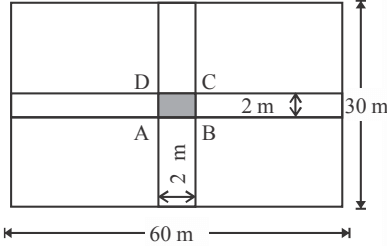 (a) 1441 m2
(a) 1441 m2
(b) 1624 m2
(c) 1328 m2
(d) All of these
 View Answer
View Answer 
Ans: (b)
Area left for gardening = Area of garden + area of two paths at the centre – Area of paths
= 60 × 30 + 4 – 120 – 60
= 1800 + 4 – 180 = 1624 m2
Q32: Find the perimeter of the following figure.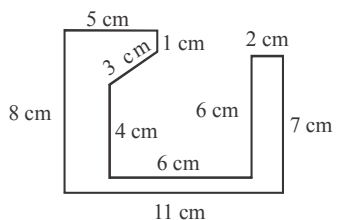
(a) 53 cm
(b) 41 cm
(c) 64 cm
(d) 45 cm
 View Answer
View Answer 
Ans: (a)
Perimeter = sum of lengths of all sides of the closed figure
= 5 + 8 + 11 + 7 + 2 + 6 + 6 + 4 + 3 + 1 = 53 cm
Q33: In the given diagram, the shaded region is a large circle with a small circle cut out of it. The large circle has radius 30 cm and centre H. HK is the diameter of the small circle.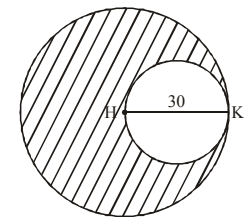 Find the perimeter of the shaded region.
Find the perimeter of the shaded region.
(a) 280.5 cm
(b) 282.85 cm
(c) 285 cm
(d) 283.5 cm
 View Answer
View Answer 
Ans: (b)
Circumference of large = 2π(30)
Circumference of small = 2π(15)
Perimeter of shaded region = circumference of larger circle + circumference of smaller circle
=2π(30)+2π(15)=2π(30+15)
=2π(45)=2×22/7×45=282.85cm
Q34: Find the area and the perimeter of the figure given below, if PQ = QR = RS = SP = 10 cm and QM = 6cm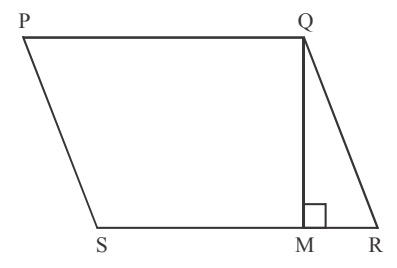 (a) 40 cm2, 60 cm
(a) 40 cm2, 60 cm
(b) 60 cm2, 24 cm
(c) 50 cm2, 50 cm
(d) 60 cm2, 40 cm
 View Answer
View Answer 
Ans: (d)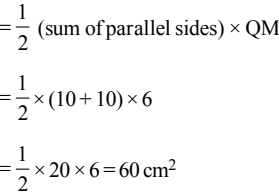
Perimeter of figure = 10 + 10 + 10 + 10 = 40 cm
Q35: Find K if 64 ÷ K = 4
(a) 4
(b) 8
(c) 16
(d) 20
 View Answer
View Answer 
Ans: (c)
Everyday Mathematics
Q36: How much wire is required to enclose a garden that measures 526.75 m in length and 225.46 m in width?
(a) 1604.42 m
(b) 753.4 m
(c) 1504.42 m
(d) 752.21 m
 View Answer
View Answer 
Ans: (c)
- To find the total length of wire needed for fencing, we calculate the perimeter of the garden.
- The formula for the perimeter of a rectangle is P = 2 × (length + width).
- Substituting the values: P = 2 × (526.75 m + 225.46 m) = 2 × 752.21 m = 1504.42 m.
- Thus, the total wire required for fencing the garden is 1504.42 m.
Q37: Nitin has a credit card with a bank limit of ₹50,000. However, he purchases a cellphone for ₹62,000. What will be the amount reflected in his bank statement as remaining in his account? (Write the amount as an integer.)
(a) ₹12,000
(b) –₹12,000
(c) ₹20,000
(d) –₹20,000
 View Answer
View Answer 
Ans: (b)
- The credit card limit is ₹50,000.
- Nitin spends ₹62,000 on a cellphone, which exceeds his limit.
- This results in a deficit of ₹12,000 (₹62,000 - ₹50,000 = –₹12,000).
- Thus, the amount shown in his bank statement will be negative, indicating he owes money.
Q38: The weight of three friends is in the ratio 2 : 5 : 7. If their total weight is 126 kg 350 g, then find the weight of the heaviest person.
(a) 63 kg 175 g
(b) 64 kg 750 g
(c) 46 kg 250 g
(d) 65 kg 125 g
 View Answer
View Answer 
Ans: (a)
- First, we need to find the total parts in the ratio: 2 + 5 + 7 = 14 parts.
- The total weight is 126 kg 350 g, which is equal to 126350 g.
- Now, to find the weight of one part, we divide the total weight by the total parts: 126350 g / 14 = 9025 g.
- The weight of the heaviest person, who has 7 parts, is 7 * 9025 g = 63175 g, which converts to 63 kg 175 g.
Q39: There are 222 red balls in a basket. A boy takes out 6 red balls from it and replaces them with 12 white balls. He continues to do so, till all red balls are replaced by white balls. Then the total number of white balls put in the basket is ______.
(a) 333
(b) 444
(c) 345
(d) 400
 View Answer
View Answer 
Ans: (b)
- The boy starts with 222 red balls.
- Each time he removes 6 red balls and adds 12 white balls.
- To find out how many times he can do this, we divide 222 by 6, which gives 37 times (with a remainder).
- In total, he adds 12 white balls for each of those 37 times, resulting in 444 white balls added to the basket.
Q40: The current age of Reena is one-fourth of her father's age. If her father is currently 52 years old, how old will Reena be in 7 years?
(a) 24 years
(b) 20 years
(c) 27 years
(d) 23 years
 View Answer
View Answer 
Ans: (b)
- Reena's current age is calculated as 1/4 of her father's age. Since her father is 52 years old, Reena is 52 / 4 = 13 years old.
- In 7 years, Reena will be 13 + 7 = 20 years old.
- Thus, the answer is 20 years, which corresponds to option (b).
Q41: Aarav is ascending the steps to a hilltop. He is currently on step m. The total number of steps to the hilltop is 10 less than 4 times the step Aarav has reached. How can we express the total number of steps in terms of m?
(a) 4m – 10
(b) 4 – 10m
(c) m – 40
(d) 3m – 10
 View Answer
View Answer 
Ans: (a)
- The total number of steps is described as 10 less than 4 times the step Aarav is on, which is m.
- To express this mathematically, we calculate 4 times m, which is 4m.
- Then, we subtract 10 from this value, leading to the expression 4m - 10.
- Thus, the correct expression for the total number of steps is 4m - 10.
Q42: Every day, a factory produces 1020 bolts. What will be the total number of bolts produced in the months of September, October, November, and December? (Assume the factory operates every day during these 4 months.)
(a) 183700
(b) 124440
(c) 184700
(d) 129440
 View Answer
View Answer 
Ans: (b)
- To find the total number of bolts produced, first calculate the number of days in the four months: September (30 days), October (31 days), November (30 days), and December (31 days).
- This gives a total of 30 + 31 + 30 + 31 = 122 days.
- Now, multiply the number of days by the daily production: 122 days * 1020 bolts/day = 124440 bolts.
- Thus, the total number of bolts manufactured in these four months is 124440.
Q43: The distance from Delhi to Mumbai is 1420 km. A person traveled 920 km by train and the rest by bus. What fraction of the total distance was traveled by bus?
(a) 71/25
(b) 25/71
(c) 27/75
(d) 35/72
 View Answer
View Answer 
Ans: (b)
- First, calculate the distance traveled by bus: 1420 km - 920 km = 500 km.
- Next, find the fraction of the total distance that this represents: 500 km / 1420 km.
- Simplifying this fraction gives us 25/71.
- Thus, the fraction of the distance covered by bus is 25/71.
Q44: Which of the following statements is incorrect?
(a) 161 and 168 are not coprime numbers.
(b) A number is divisible by 3, if the sum of all its digits is divisible by 3.
(c) The sum of the integers –8 + 23 + (–31) is greater than the sum of integers –31 + 7 – (–3).
(d) The sum of two numbers is –196. If one number is 142, then the other number is –338.
 View Answer
View Answer 
Ans: (c)
- The statement in option (c) claims that the sum of –8 + 23 + (–31) is greater than the sum of –31 + 7 – (–3).
- Calculating the first sum: –8 + 23 + (–31) equals –16.
- Calculating the second sum: –31 + 7 + 3 equals –21.
- Since –16 is actually greater than –21, the statement is incorrect.
Q45: There are 8436 steel balls, each with a radius of 1 centimeter, stacked in a pile, with 1 ball on top, 3 balls in the second layer, 6 in the third layer, 10 in the fourth, and so on. The number of horizontal layers in the pile is
(a) 30
(b) 33
(c) 36
(d) 39
 View Answer
View Answer 
Ans: (c)
Achievers Section
Q46: Paul, Quincy, Rochelle, Surinder, and Tony are sitting around a table. Quincy sits in the chair between Paul and Surinder. Tony is not beside Surinder. Who is sitting on either side of Tony?
(a) Paul and Rochelle
(b) Quincy and Rochelle
(c) Paul and Quincy
(d) Surinder and Quincy
 View Answer
View Answer 
Ans: (a)
Q47: ABCD is a square that is made up of two identical rectangles and two squares of area 4 cm2 and 16 cm2. What is the area, in cm2, of the square ABCD?
(a) 64
(b) 49
(c) 25
(d) 36
 View Answer
View Answer 
Ans: (d)
One way to draw the required square is shown in the diagram. The smaller square has a side length of 2 cm and the larger a side length of 4 cm. This gives the side length of the larger square to be 6 cm and an area of 36 cm2.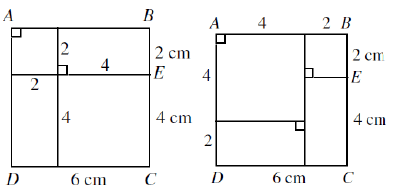
Q48: A dishonest butcher priced his meat so that meat advertised at $3.79 per kg was actually sold for $4.00 per kg. He sold 1800 kg of meat before being caught and fined $500. By how much was he ahead or behind where he would have been had he not cheated?
(a) $478 loss
(b) $122 loss
(c) Breaks even
(d) $122 gain
 View Answer
View Answer 
Ans: (b)
The butcher gained $0.21 on each kg he sold and thus he dishonestly made (0.21)(1800) = $378.00. After paying the $500 fine, he would have a loss of $500 - $378 = $122.
Q49: Identify the equivalent ratio of 5: 7 from the options given below. (2015)
(a) 10: 14
(b) 15: 21
(c) 20: 28
(d) All of these
 View Answer
View Answer 
Ans: (d)
5 : 7 = 5/7
Then, equivalent ratios are 
Q50: 1500 sheets are required to make 100 notebooks. How many sheets will be required to make 12 note books?
(a) 180
(b) 200
(c) 120
(d) 100
 View Answer
View Answer 
Ans: (a)
(a) 100 notebooks = 1500 sheets
12 notebooks = 1500/100 x 12
= 180 sheets
|
30 videos|120 docs|59 tests
|
FAQs on Maths Olympiad Previous Year Paper -3 - Maths Olympiad Class 6
| 1. What topics are covered in the Maths Olympiad for Class 6? |  |
| 2. How can I prepare effectively for the Class 6 Maths Olympiad? |  |
| 3. Are there any specific books or resources recommended for Class 6 Maths Olympiad preparation? |  |
| 4. What is the format of the Class 6 Maths Olympiad exam? |  |
| 5. How can participating in Maths Olympiad benefit students? |  |















